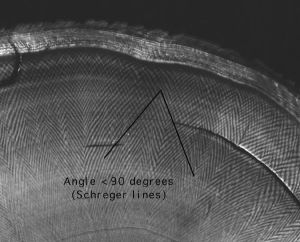Schreger lines: Difference between revisions
No edit summary |
No edit summary |
||
| Line 1: | Line 1: | ||
[[File:Schreger lines in mammoth ivory.jpg|alt=From http://www.lab.fws.gov/Ivory/elephant.html|thumb|'''Schreger lines in mammoth ivory''']] | [[File:Schreger lines in mammoth ivory.jpg|alt=From http://www.lab.fws.gov/Ivory/elephant.html|thumb|'''Schreger lines in mammoth ivory''']] | ||
'''Schreger lines''' are visual artifacts that are evident in the cross-sections of [[ivory]].<ref> | '''Schreger lines''' are visual artifacts that are evident in the cross-sections of [[ivory]].<ref> | ||
Espinoza, Edgard O'Neil; Mann, Mary-Jacque (1991). The identification guide for ivory and ivory substitutes. p. 10. | Espinoza, Edgard O'Neil; Mann, Mary-Jacque (1991). ''The identification guide for ivory and ivory substitutes''. p. 10.</ref> They are commonly referred to as cross-hatchings, engine turnings, or stacked chevrons. Schreger lines can be divided into two categories. The easily seen lines which are closest to the [[cementum]] are the ''outer Schreger lines''. The faintly discernible lines found around the [[tusk nerve]] or [[pulp cavities]] are the ''inner Schreger lines''. The intersections of Schreger lines form angles, which appear in two forms: [[concave angles]] and [[convex angles]]. Concave angles have slightly concave sides and open to the medial (inner) area of the [[tusk]]. Convex angles have somewhat convex sides and open to the lateral (outer) area of the tusk. Outer Schreger angles, both concave and convex, are acute in extinct [[proboscidea]] and obtuse in extant proboscidea.<ref>US Fish and Wildlife Service. "[https://web.archive.org/web/20190214103227/http://www.fws.gov/lab/ivory_natural.php#elephant Ivory Identification Guide]".</ref> | ||
== Notes == | == Notes == | ||
Latest revision as of 11:43, 20 October 2025

Schreger lines are visual artifacts that are evident in the cross-sections of ivory.[1] They are commonly referred to as cross-hatchings, engine turnings, or stacked chevrons. Schreger lines can be divided into two categories. The easily seen lines which are closest to the cementum are the outer Schreger lines. The faintly discernible lines found around the tusk nerve or pulp cavities are the inner Schreger lines. The intersections of Schreger lines form angles, which appear in two forms: concave angles and convex angles. Concave angles have slightly concave sides and open to the medial (inner) area of the tusk. Convex angles have somewhat convex sides and open to the lateral (outer) area of the tusk. Outer Schreger angles, both concave and convex, are acute in extinct proboscidea and obtuse in extant proboscidea.[2]
Notes
- ↑ Espinoza, Edgard O'Neil; Mann, Mary-Jacque (1991). The identification guide for ivory and ivory substitutes. p. 10.
- ↑ US Fish and Wildlife Service. "Ivory Identification Guide".
